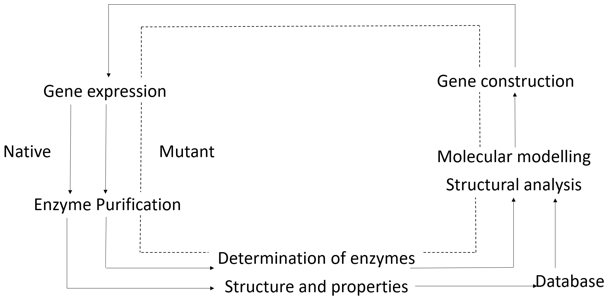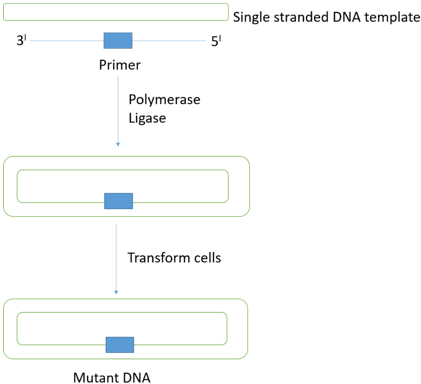This set of Enzyme Technology Multiple Choice Questions & Answers (MCQs) focuses on “Future Prospects – Enzyme Engineering”.
1. Which of the following property may not be improved or altered using genetic engineering?
a) Yield and Kinetics
b) Various safety aspects
c) Ease of downstream processing
d) Accurate, precise, reproducible and linear
View Answer
Explanation: The response should be accurate, precise, reproducible and linear over the useful analytical range, without dilution or concentration. It should also be free from electrical noise. It is a property of a biosensor. Hence, it may not be improved or altered using genetic engineering. The properties which may be improved or altered using genetic engineering are as follows:
• Yield and Kinetics.
• Various safety aspects.
• Ease of downstream processing.
2. Which of the following property may not be improved or altered using genetic engineering?
a) Enzymes from dangerous or unapproved microorganisms may be cloned into safe high-production microorganisms
b) Enzymes from slow growing or limited plant or animal tissue may be cloned into safe high-production microorganisms
c) If the biosensor is to be used for invasive monitoring in clinical situations, the probe must be tiny and biocompatible, having no toxic or antigenic effects
d) Enzymes may be redesigned to fit more appropriately into industrial processes
View Answer
Explanation: If the biosensor is to be used for invasive monitoring in clinical situations, the probe must be tiny and biocompatible, having no toxic or antigenic effects. This property belongs to biosensor and hence may be improved or altered using genetic engineering. But the properties which can be altered are as follows:
• Enzymes from dangerous or unapproved microorganisms may be cloned into safe high-production microorganisms.
• Enzymes from slow growing or limited plant or animal tissue may be cloned into safe high-production microorganisms.
• Enzymes may be redesigned to fit more appropriately into industrial processes.
3. The property of increasing the amount of the enzyme by increasing the number of gene copies is used increase the activity of __________ in E. Coli.
a) Subtilisin
b) Trypsin
c) Penicillin-G-amidase
d) Glucose isomerase
View Answer
Explanation: The property of increasing the amount of the enzyme by increasing the number of gene copies is used increase the activity of penicillin -G-amidase in E. coli. Enzymes may be redesigned to fit more appropriately into industrial processes, as in case of glucose isomerase which is made less susceptible to inhibition by the Ca2+ present in the starch saccharification processing stream. Subtilisin has been aimed at the improvement of its activity in detergents by stabilizing it at even higher temperatures, pH and oxidant strength. Trypsin has an active site closely related to that of subtilisin and hence genetic engineering in trypsin gives the predictable result of abolishing the activity against its normal substrates, but unpredictably gives no activity against substrates where these basic residues are replaced by aspartic acid or glutamic acid.
4. What is represented in the following diagram?

a) Protein engineering cycle
b) Site directed mutagenesis
c) Polymerase chain reaction
d) Transcription
View Answer
Explanation: The diagram represents a protein engineering cycle. The steps of the cycle are as follows:
• First step is isolation and characterization of the required enzyme.
• This follows the analysis of information gathered along with the database of known structural effects of amino acid substitutions to produce a possible improved structure.
• Then, the enzyme of interest is constructed by site-directed mutagenesis, isolated and characterized.
• After this, the results obtained, successful or unsuccessful, are added to the database, and the process repeated until the required result is obtained.
5. Which of the following is not a step in producing penicillin -G-amidase?
a) Cleavage by Hind III
b) Replacement of asparagine residue with serine present in the native enzyme
c) Cleaved fragments cloned into a cosmid vector
d) Penicillin-G-amidase gene transferred on to pBR322 plasmids
View Answer
Explanation: Replacement of asparagine residue with serine present in the native enzyme is a step involved in site directed mutagenesis and not in production of penicillin –G-amidases. The steps involved are as follows:
• Cleavage of DNA by Hind III at relatively rare sites containing the 5′-AAGCTT-3′.
• The cleaved DNA is cloned into a cosmid vector and then returned to E. coli.
• Followed by selection of colonies containing the active gene by their inhibition of a 6-amino-penicillanic acid-sensitive organism.
• Such colonies are isolated and the penicillin-G-amidase gene is transferred on to pBR322 plasmids and re-cloned back into E. coli.
• The engineered cells produce penicillin-G-amidase constitutively and in considerably higher quantities than parental strain.
6. Protein engineering directed at subtilisin has been aimed to improve the activity in detergents by stabilizing it at even higher temperatures, pH and oxidant strength with some concerned alterations.
a) True
b) False
View Answer
Explanation: Protein engineering directed at subtilisin has been aimed to improve the activity in detergents by stabilizing it at even higher temperatures, pH and oxidant strength with some concerned alterations. The concerns are as follows:
• The P1 cleft which holds the amino acid on the carbonyl side of the targeted peptide bond.
• The oxyanion hole residue at 155 which stabilizes the tetrahedral intermediate.
• The neighborhood of the catalytic histidyl residue at 64 which has a general base role.
• The methionine residue at 222 which causes subtilisin lability to oxidation.
Hence the above statement is true.
7. Which of the following is not a step involved in site directed mutagenesis using a hypothetical example?
a) Derive the primary structure of the enzyme from the DNA sequence
b) Identification of mutant DNA by hybridization with radioactively labelled oligonucleotides
c) Cleavage by Hind III
d) Primary structure of putative enzyme is proposed with an asparagine residue replacing the serine present in the native enzyme
View Answer
Explanation: Cleavage by Hind III is a step involved in production of penicillin – G – amidases and not site directed mutagenesis. The steps involved in site directed mutagenesis are as follows:
• Derive the primary structure of the enzyme from the DNA sequence.
• Primary structure of putative enzyme is proposed with an asparagine residue replacing the serine present in the native enzyme.
• Synthesis of primer which is complementary to a section of the gene apart from the base mismatch.
• The oligonucleotide primer is annealed to a single-stranded copy of the gene and polymerase chain reaction occurs which produces both mutant and wild-type clones.
• Identification of mutant DNA by hybridization with radioactively labelled oligonucleotides.
8. Which of the following techniques may not be used to produce thermophilic enzymes?
a) Internal salt link
b) Extra internal hydrophobic residues
c) Suitable exterior substitutions
d) Primary structure of putative enzyme is proposed with an asparagine residue replacing the serine present in the native enzyme
View Answer
Explanation: Primary structure of putative enzyme is proposed with an asparagine residue replacing the serine present in the native enzyme is a major step involved in site directed mutagenesis. The techniques which may be used to produce thermophilic enzymes are as follows:
• Addition of just a few extra hydrogen bonds, an internal salt link and extra internal hydrophobic residues which will give a slightly more hydrophobic core.
• Suitable exterior substitutions to conserve the secondary structure of the enzyme which ensures more predictable outcome.
9. What is represented in the following diagram?

a) Protein engineering cycle
b) Site directed mutagenesis
c) Replication
d) Transcription
View Answer
Explanation: The diagram represents the process of site directed mutagenesis which starts with deprival of primary structure of the enzyme from the DNA sequence. Primary structure of putative enzyme is proposed with replacing another aminoacid present in the native enzyme. This is followed by synthesis of primer which is complementary to a section of the gene apart from the base mismatch. The oligonucleotide primer is then annealed to a single-stranded copy of the gene and polymerase chain reaction occurs which produces both mutant and wild-type clones. Finally, the mutant DNA is identified by hybridization with radioactively labelled oligonucleotides.
Sanfoundry Global Education & Learning Series – Enzyme Technology.
To practice all areas of Enzyme Technology, here is complete set of 1000+ Multiple Choice Questions and Answers.
If you find a mistake in question / option / answer, kindly take a screenshot and email to [email protected]
- Apply for Biotechnology Internship
- Apply for Chemical Engineering Internship
- Check Chemical Engineering Books
- Check Biotechnology Books
- Practice Chemical Engineering MCQs
